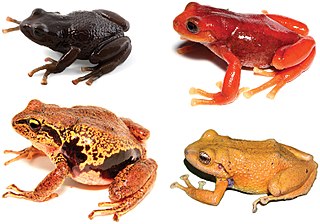
The Percidae are a family of ray-finned fish, part of the order Perciformes, which are found in fresh and brackish waters of the Northern Hemisphere. The majority are Nearctic, but there are also Palearctic species. The family contains more than 200 species in 11 genera. The perches, and their relatives are in this family; well-known species include the walleye, sauger, ruffe, and three species of perch. However, small fish known as darters are also a part of this family.

Astyanax is a genus of freshwater fish in the family Characidae of the order Characiformes. Some of these fish, like many of their relatives, are kept as aquarium pets and known collectively as tetras. With around 150 described species and new ones being described yearly, this genus is among the largest of the entire order; Hyphessobrycon also has more than 145 species and which one is larger at any one time depends on whether more species have been recently described in one or the other. The blind and colorless cave tetra of Mexico is a famous member of the genus, but its taxonomic position is disputed: Some recognize it as part of the Mexican tetra and this is supported by phylogenetic evidence, but others recognize the cave form as a separate species, A. jordani.

Trichomycteridae is a family of catfishes commonly known as pencil catfishes or parasitic catfishes. This family includes the candiru fish, feared by some people for its alleged habit of entering into the urethra of humans. They are one of the few parasitic chordates. Another species is the life monsefuano which was important to the Moche culture and still an important part of Peruvian cuisine.

River stingrays or freshwater stingrays are Neotropical freshwater fishes of the family Potamotrygonidae in the order Myliobatiformes, one of the four orders of batoids, cartilaginous fishes related to sharks. They are found in rivers in tropical and subtropical South America. A single marine genus, Styracura, of the tropical West Atlantic and East Pacific are also part of Potamotrygonidae. They are generally brownish, greyish or black, often with a mottled, speckled or spotted pattern, have disc widths ranging from 31 to 200 centimetres (1.0–6.6 ft) and venomous tail stingers. River stingrays feed on a wide range of smaller animals and the females give birth to live young. There are more than 35 species in five genera.

The Doradidae are a family of catfishes also known as thorny catfishes, raphael catfishes or talking catfishes. These fish are native to South America, primarily the Amazon basin and the Guianas.

Potamotrygon is a genus of freshwater stingrays in the family Potamotrygonidae native to the rivers of South America, and sometimes seen in the aquarium trade.

The Ecnomidae are a family of caddisflies comprising 9 genera with a total of 375 species.

Farlowella is a genus of fish in the family Loricariidae native to South America. This genus is broadly distributed in Amazon, Orinoco, Paraná and coastal rivers of the Guyana Shield. It is absent from the Pacific slope of the Andes and from the coastal rivers of the Brazilian Shield. Many of these species are kept in aquariums. This genus has a unique body shape that resembles a thin stick of wood. The body is slender and elongate, often with a pronounced rostrum and a brownish color with two lateral dark stripes beginning at the tip of the rostrum, passing over the eyes and ending at the tail, which are periodically interrupted on the caudal peduncle.
Astrodoras is a monotypic genus with the only species Astrodoras asterifrons of catfish family Doradidae. This species originates from the Amazon basin of Bolivia and Brazil and reaches a length of about 8.0 centimetres (3.1 in) SL. This genus is the type genus of the subfamily Astrodoradinae.
Merodoras nheco is species of freshwater ray-finned fish, it is the only species in the genus Merodoras of the catfish family Doradidae.

Anadoras is a genus of thorny catfishes native to tropical South America.

Helogenes is a genus of whale catfish found in tropical South America.

Heroini is a fish tribe from the Cichlasomatinae subfamily in the cichlid family. All cichlids native to the Greater Antilles, United States, Mexico and northern Central America are members of this tribe. It also includes most cichlid species in southern Central America and several species from South America. A large percentage of its species were formerly placed in the genus Cichlasoma, but have since been moved to other genera.

Chaetostoma, also known as the bristlemouth catfish, is a genus of suckermouth armored catfishes native to South America with one species, C. fischeri, extending into Panama. Most species inhabit flowing rivers in the lower Andes and its foothills. Some species are kept in unheated aquaria.

Craugastoridae, commonly known as fleshbelly frogs, is a family of New World direct-developing frogs. As delineated here, following the Amphibian Species of the World, it contains 129 species. They are found from the southern United States southwards to Central and South America.
Synaptolaemus is a genus of headstanders native to South America, where found in the Orinoco, Casiquiare and Amazon Basin. Synaptolaemus are elongate in shape and overall black with contrasting red, orange or yellow stripes.

Tyrannomyrmex is a rare tropical genus of ants in the subfamily Myrmicinae. Three similar species, only known from workers, are recognized and share small eyes and edentate mandibles.

Bryconops giacopinii is a mid-sized species of freshwater fish in the family Iguanodectidae. It is the largest member of the genus Bryconops, and is therefore difficult to confuse with any of its congeners. With a diet that consists largely of land-dwelling insects, it serves as an important link between the terrestrial and aquatic aspects of its native range.














